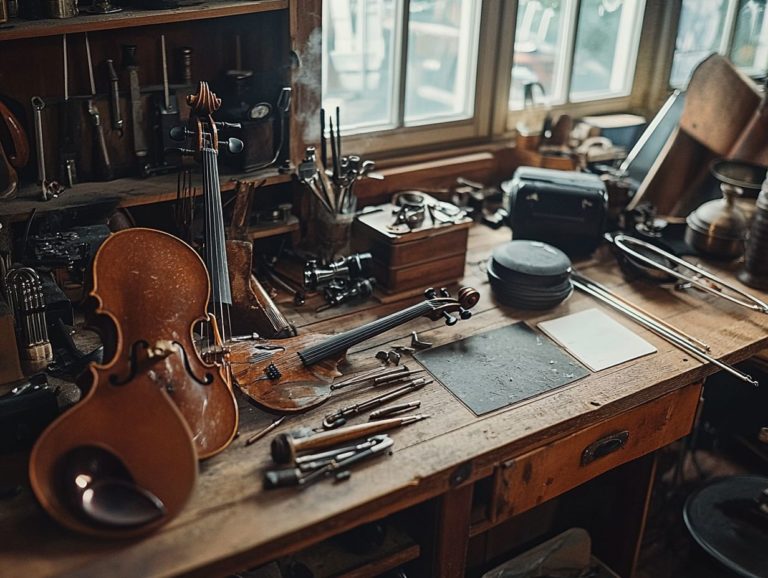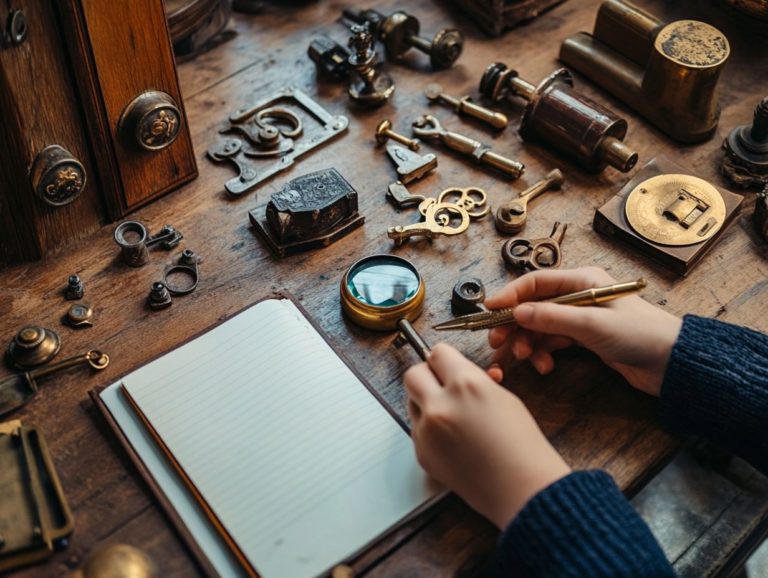A Beginner’s Guide to Vintage Furniture Repair
Vintage furniture exudes a unique charm and rich history. However, keeping it in pristine condition can be challenging.
Get ready to dive in! This guide will equip you with everything you need to know about vintage furniture repair.
You ll learn about the materials and techniques for identifying common issues. You ll discover the tools and supplies necessary for repairs like loose joints and surface refinishing.
You ll also find valuable tips to help maintain and preserve your cherished pieces for years to come. Immerse yourself in this journey and breathe new life into your vintage discoveries!
Contents
- Key Takeaways:
- The Basics of Vintage Furniture Repair
- Assessing the Condition of Vintage Furniture
- Tools and Supplies Needed for Repair
- Step-by-Step Guide to Repairing Vintage Furniture
- Tips for Maintaining and Preserving Vintage Furniture
- Frequently Asked Questions
- Your Questions Answered!
- What is vintage furniture repair?
- What are some common types of damage in vintage furniture?
- What tools are needed for vintage furniture repair?
- Can I repair vintage furniture myself?
- How do I determine the value of vintage furniture?
- What are some tips for maintaining vintage furniture?
Key Takeaways:
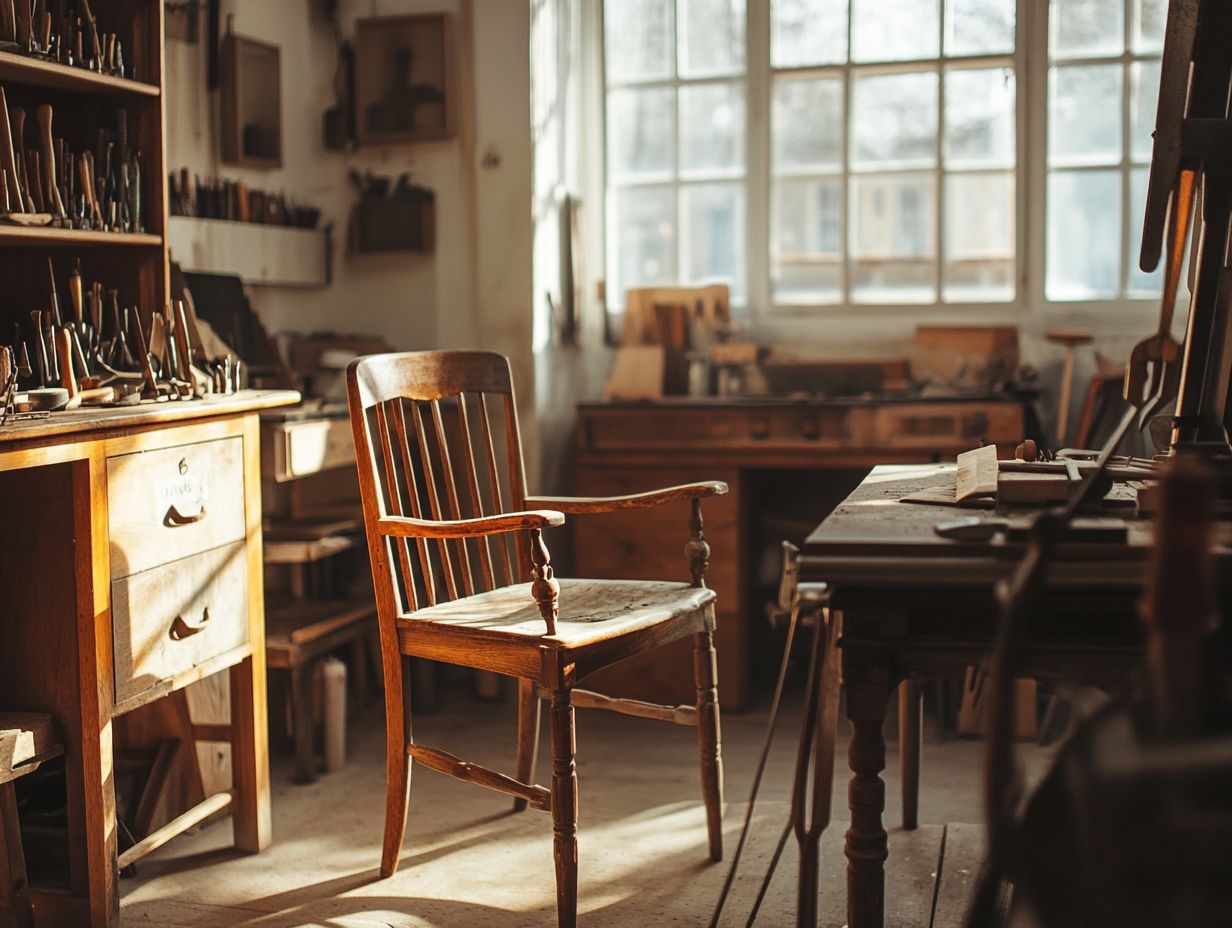
- Understand the materials and techniques for vintage furniture repair to assess and address common damage.
- Having the right tools and supplies is essential for restoring vintage furniture.
- Regular maintenance helps preserve the beauty and value of vintage pieces.
The Basics of Vintage Furniture Repair
Vintage furniture repair includes various techniques designed to restore old pieces while honoring their history. This process boosts their beauty and preserves their value, allowing you to celebrate craftsmanship from past eras.
Artisans like Terri Llanes from Painted Pink Peony Co show how expert refurbishing can create breathtaking transformations that resonate with individual tastes and community values.
Understanding Materials and Techniques
To restore old furniture, you need to understand the materials involved. This includes knowing the types of wood you are working with and the best sanding methods.
Different woods like oak, maple, and pine bring unique characteristics that influence your choice of stains and paints. For example, oak is durable and takes stains beautifully, whereas pine may need a primer for paint adhesion.
To achieve a flawless finish, use effective sanding techniques, gradually smoothing the surface. If stubborn paint remains, chemical strippers can help create a clean base for your new finish.
Choosing the right materials enhances both the appearance and longevity of your furniture. Meticulous preparation is key to successful refinishing.
Assessing the Condition of Vintage Furniture
Assessing the condition of vintage furniture is crucial in your restoration journey. This careful evaluation helps identify issues that need your attention before you start repairs.
By examining each piece closely, you ensure it receives the care and precision it deserves. This paves the way for stunning transformations that honor its design and rich history.
Identifying Common Issues and Damage
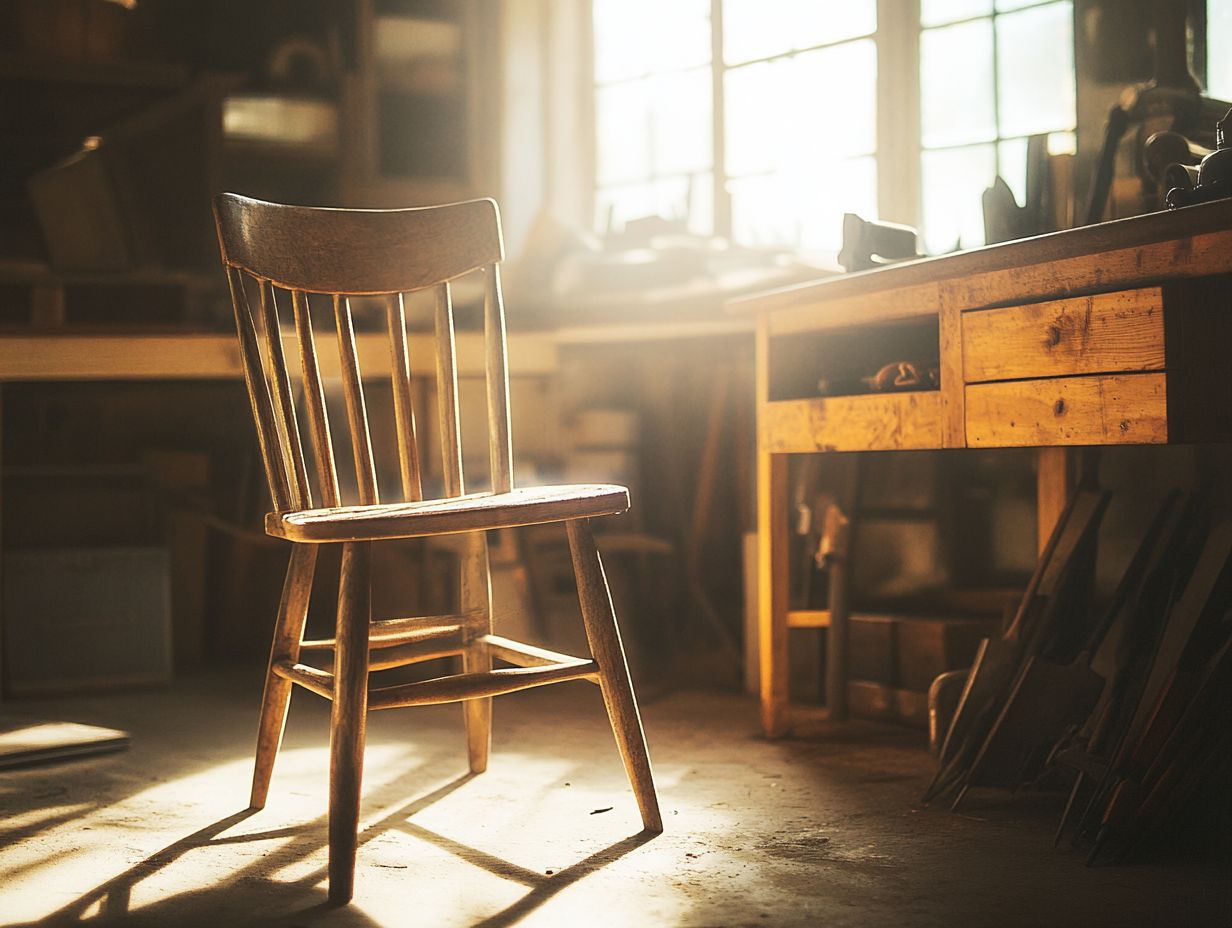
Identifying issues in vintage furniture is crucial for effective assessment and planning. You may come across scratches, dents, and water damage problems that can impact both aesthetics and structural integrity.
Look closely for scratches or uneven textures that suggest deeper damage. Water stains usually appear as discoloration, indicating moisture exposure that could lead to warping.
Recognizing these flaws is vital for determining the right refinishing approach. A thorough evaluation allows you to tailor the restoration to enhance both appearance and durability, preserving the beauty of vintage furniture for years to come.
Tools and Supplies Needed for Repair
Equipping yourself with the right tools and supplies is essential for any vintage furniture repair project. Preparing the right tools ensures a smooth workflow.
Gather essential items such as safety equipment and sanding tools. Prepare a suitable workspace to foster creativity and precision, setting the stage for your craftsmanship.
Essential Tools and Materials for Different Types of Repairs
When repairing vintage furniture, grasping the essential tools and materials is crucial for various types of repairs. Heat guns and chemical strippers are your allies for effective refinishing.
Also, don t underestimate the value of sanding blocks and orbital sanders. They work wonders in smoothing surfaces. Quality brushes and spray guns are essential for achieving flawless paint application.
Don t forget to consider the wood type and finish you are dealing with. Harder woods like oak may require more robust tools compared to softer woods like pine.
For joint repairs, ensure your toolkit includes wood glue and clamps, as they provide strong bonds and lasting durability.
Choosing the right grain filler or finishing oil is critical. This enhances your project’s aesthetic and contributes to its longevity, making careful selection essential.
Step-by-Step Guide to Repairing Vintage Furniture
A step-by-step guide to repairing vintage furniture gives you the confidence to tackle your DIY projects, transforming pieces into captivating focal points.
By following a structured approach to refinishing, you can execute each stage with care, resulting in beautiful transformations that honor the original craftsmanship and historical value of your furniture.
Repairing Loose Joints and Missing Pieces

Repairing loose joints and missing pieces is essential when refurbishing vintage furniture. This ensures structural integrity and prolongs the life of your cherished items.
Try these exciting techniques to tackle these challenges! You can employ gluing or dowel techniques. Choose glue that s compatible with the materials you are using. This provides a lasting bond while preserving the piece’s original character.
Doweling is another excellent option, offering additional support for heavier items. It discreetly reinforces joints without drawing attention away from the piece itself.
For any missing pieces, sourcing materials that match the original wood grain and finish is vital to maintain visual cohesion. Balancing modern repair methods with historical accuracy is crucial, so document any alterations.
These practices preserve the integrity of the vintage style and allow future generations to appreciate the craftsmanship.
Refinishing and Restoring Wood Surfaces
Refinishing and restoring wood surfaces is essential for enhancing the beauty and durability of your vintage furniture. You can dissolve old finishes and apply fresh stains and paints.
The process starts with carefully removing the existing finish. You can achieve this through various methods. Employ sanding techniques, from coarse to fine grits, to gradually strip away layers without harming the wood beneath.
For intricate designs or stubborn finishes, consider using chemical strippers or heat guns for more efficient removal.
When selecting stains and paints, consider the type of wood to ensure compatibility and preserve the unique character of the piece.
Using finishes that respect the furniture’s historical value is paramount, as it maintains the integrity of craftsmanship and enhances its visual allure.
Tips for Maintaining and Preserving Vintage Furniture
Using effective strategies for maintaining and preserving vintage furniture can greatly extend its lifespan, safeguarding its craftsmanship and historical value while ensuring these exquisite pieces continue to captivate for generations.
By adhering to preventative measures and care instructions, you can protect your cherished items from damage and deterioration, allowing their beauty to shine through.
Preventative Measures and Care Instructions
Establishing care measures is key to keeping your vintage treasures vibrant! Tailoring your care practices to suit the material and finish of each piece be it solid wood, upholstery, or metal is essential.
Regular dusting and using appropriate cleaning solutions can significantly enhance longevity. Avoid prolonged sunlight exposure to help maintain color integrity. Watch humidity levels to maintain your vintage furniture.
Engaging with your community through educational workshops or local groups can also play a significant role in sharing best practices. Together, you can ensure these historical artifacts are not only cherished but preserved for future generations.
Frequently Asked Questions
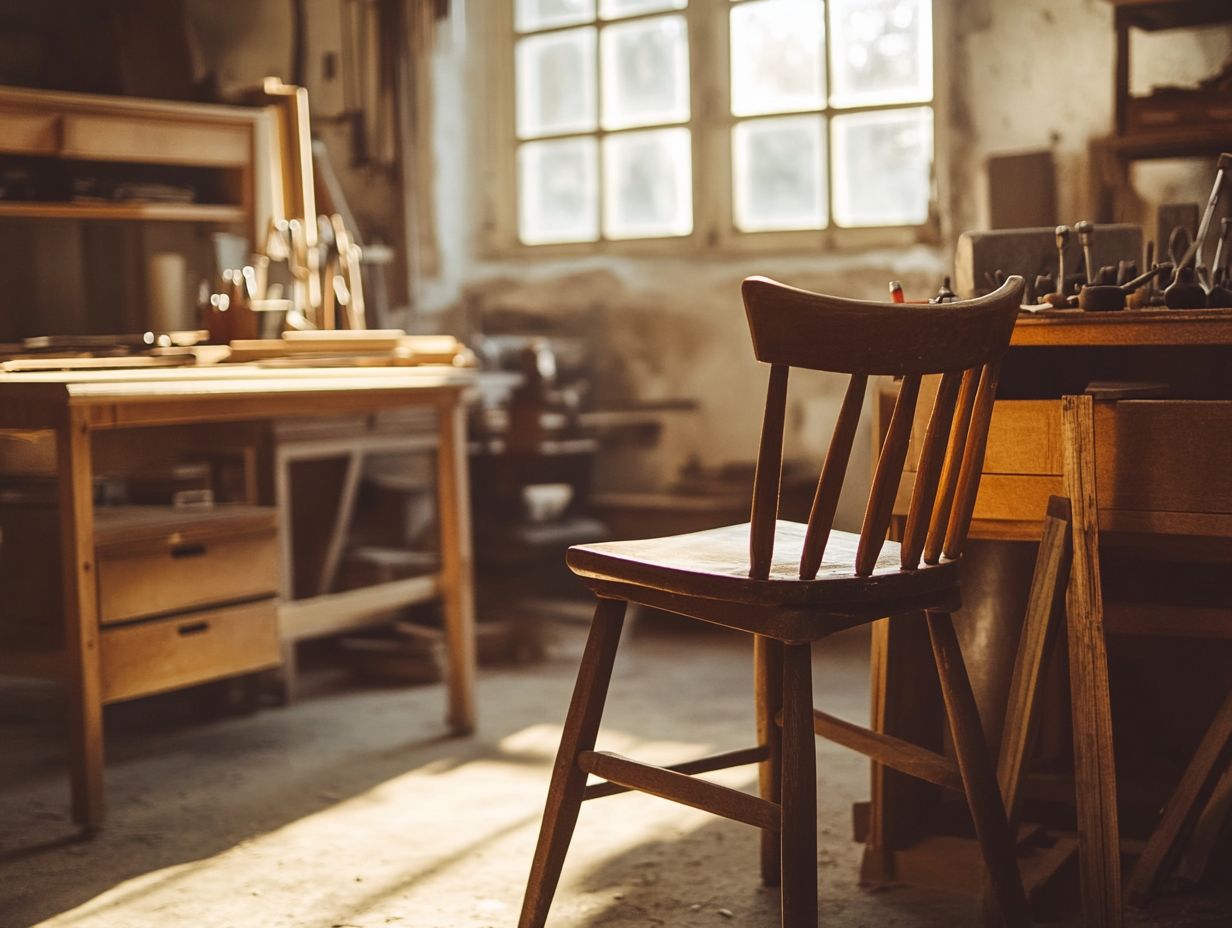
Your Questions Answered!
What is vintage furniture repair?
Vintage furniture repair is the process of restoring and fixing vintage furniture to its original condition. It involves repairing any damages, refinishing or repainting, and replacing any missing parts to bring the piece back to its former glory.
What are some common types of damage in vintage furniture?
Some common types of damage in vintage furniture include scratches, dents, water damage, broken or loose joints, and missing or damaged hardware. These damages can occur due to age, wear and tear, or improper storage or handling.
What tools are needed for vintage furniture repair?
The tools needed for vintage furniture repair may vary depending on the type of repair needed. However, some essential tools include sandpaper, wood glue, clamps (which hold pieces together while the glue dries), screws, wood filler (used to fill in cracks or holes), and various hand tools such as hammers, screwdrivers, and chisels.
Can I repair vintage furniture myself?
Yes, it is possible to repair vintage furniture yourself with the right tools, materials, and knowledge. However, assess the level of damage and your own skill level before attempting any repairs. For more complex repairs, it may be best to seek the help of a professional.
How do I determine the value of vintage furniture?
The value of vintage furniture can vary greatly depending on factors such as its age, condition, rarity, and historical significance. Research similar pieces online or consult with an appraiser to get an idea of its value. Keep in mind that the value of a piece may also depend on the market and current trends.
What are some tips for maintaining vintage furniture?
To maintain vintage furniture, regularly clean and dust the piece, avoid placing it in direct sunlight or near sources of heat, and use coasters or protective pads to prevent scratches. Periodically check for any damages or wear and tear and address them promptly to prevent further damage.
Join a local workshop today to learn more about preserving your vintage pieces!





